VW Wolkswagen Beetle maintenance repair service manual
The Volkswagen Beetle, officially called the Volkswagen Type 1, is an economy automobile yielded by the German car creator Volkswagen from 1938 till 2003.Although crafted inside the 1930s, the Beetle was just yielded inside immense numbers from 1945 about whenever
How to Rebuild Your Volkswagen Air-Cooled Engine 1961 onwards
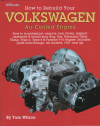
Rebuild Aircooled VW Engines HP255 by Tom WilsonGet other VW repair manuals hereA guide to engine rebuilding includes discussions of removal parts indentification cylinder head reconditioning and engine assembly Integracar tries to make available a diverse array of workshop guides. But owners manuals can be created for assorted countries and the motor cars engineered for those nations. That means not all service manuals may be acceptable for your particular car. If you have queries whether a particular repair manual is relevant for your automobile kindly contact us hereRebuild Aircooled VW Engines HP255 by Tom Wilson
Volkswage VW Beetle 1100 1500 1954-1971 Gregorys Service Repair Manual
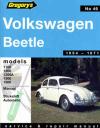
Get other VW repair manuals hereVolkswagen Beetle 1100 - 1500 1954 - 1971 Gregorys Owners Service Repair Manual covers 1100 1200 1200A 1300 and 1500 models fitted with the four-speed manual transmission (both the split casing box with synchromesh on 2nd 3rd and 4th and the later all synchromesh box) or the Stickshift automatic transmission.Engines covered are all horizontally opposed OHV 4-cylinder air-cooled in the following capacities: 1100cc 1200cc 1300cc 1500ccContents: Engine Fuel Clutch Stickshift Automatic Transmission Transmission and Rear Axle Steering Front Axle and Suspension Rear Suspension Brakes Electrical System Wiring Diagrams Body Wheels and Tyres Lubrication and MaintenanceNOTE: Only maintenance adjustment minor repair procedures plus removal and installation are described for the Transmissions.
Volkswagen VW Beetle 1999-2007 repair, workshop manual NEW
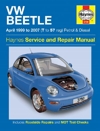
This manual covers:#9679; Hatchback (plus major mechanical features of Cabriolet) inc. special/limited editions. Does NOT cover Tiptronic transmission#9679; Petrol: 1.4 litre (1390cc) 1.6 litre (1595cc) 1.8 litre (1781cc) turbo 2.0 litre (1984cc). Does NOT cover 2.3 litre V5 engine.#9679; Diesel: 1.9 litre (1896cc) turbo inc. PDNOTE: Only maintenance adjustment minor repair procedures plus removal and installation are described for the transmissions.Inside this manual you will find: Routine Maintenance tune-up procedures engine repair cooling and heating air-conditioning fuel and exhaust emissions control ignition brakes suspension and steering electrical systems and wiring diagrams.Haynes repair manuals can save you money on maintenance and repair bills. Step-by-step procedures and illustrations guide you through every job from basic maintenance and troubleshooting to complete teardown rebuild.Information on Repair and Service ManualsNote that repair manuals are normally produced for models sold in a particular country.Differences in specification can exist between models sold in different countries and it
Volkswagen VW Super Bug 1600 1971 1975 Gregorys Service Repair Manual
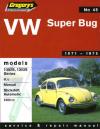
VW Volkswagen Superbug 1600 - 1302S 1303S 1971-1975 NEW paperbackOther VW Volkswagen Repair Manuals click here Volkswagen VW Super Bug 1600 1971 - 1975 Gregorys Owners Service Repair Manual covers the Australian spec Super Bug 1302S and 1303S series S and L fitted with the 1600c engine 4 cylinder engine.Engine Covered: Type 1 1600 (1584 cc) horizontally opposed 4-cylinderTransmissions covered: 4-speed manual 3-speed Stickshift Automatic NOTE: Only maintenance adjustment minor repair procedures plus removal and installation are described for the transmissions. Covers everything you need to know step by step procedures hundreds of photographs and illustrations routine maintenance wiring diagrams repairs and overhauls and what tools to buy. Gregory s manuals are based on an actual vehicle stripdown and are researched and written by automotive engineers with vast experience.
Volkswagen VW Beetle Karmann Ghia 1954 1979 Haynes Service Repair Manual
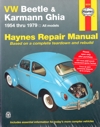
VW Volkswagen Beetle and Karmann Ghia Service and Repair Manual 1954 - 1979 HaynesGet Other Volkswagen Repair Manuals click here NEW softcover 318 pages US VW Beetle Karmann Ghia 1954 - 1979 Haynes Owners Service Repair Manual covers: Beetle 1954 - 1979 and Karmann Ghia 1956 - 1975.Engines covered (are all boxer 4-cylinder air-cooled): 1200 (1192 cc) 1300 (1285 cc) 1500 (1493 cc) 1600 (1584 cc) Single port 1600 (1584 cc) Dual port Transmissions Covered (no overhaul data for automatic): Split-case 4-speed manual Single-piece case 4-speed manual Automatic Stick Shift 3-speed semi-automatic - manual shift with torque converter and automatic clutch Inside this manual you will find: Routine Maintenance tune-up procedures engine repair cooling and heating air-conditioning fuel and exhaust emissions control ignition brakes suspension and steering electrical systems and wiring diagrams. Haynes repair manuals can save you money on maintenance and repair bills. Step-by-step procedures and illustrations guide you through every job from basic maintenance and troubleshooting to complete teardown rebuild.
How to Keep Your Volkswagen Alive
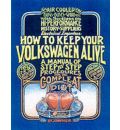
Get other VW repair manuals hereFirst published in 1969 this classic manual of automotive repair equips VW owners with the knowledge to handle every situation they will come across with any air-cooled Volkswagen built through 1978 including Bugs Karmann Ghis vans and campers. With easy-to-understand fun-to-read information- for novice and veteran mechanics alike-anecdotal descriptions and clear language this book takes mystery out of diagnostic maintenance and repair producers and offers some chuckles along the way. How to Keep Your Volkswagen Alive by John Muir
Although crafted inside the 1930s, the Beetle was just yielded inside immense numbers from 1945 about whenever the model was internally designated the Volkswagen Type 1, plus advertised just because the "Volkswagen". Later models were designated VW 1200, 1300, 1500, 1302 or 1303, the past 3 indicating engine displacement as well as the latter 2 being produced within the sort amount plus not indicative of engine capability. The model became commonly recognized inside its house nation because the Käfer plus was later advertised as a result inside Germany, plus because the Volkswagen Beetle inside different nations.
The Beetle was crafted for sustained significant speed found on the Autobahn. It eventually gave rise with variants, including the Volkswagen Karmann Ghia as well as the Volkswagen Type 2 bus. The Beetle had marked a extensive trend led by Volkswagen, Fiat, plus Renault whereby the rear-engine, rear-wheel drive design had improved from 2.6 % of continental Western Europe's automobile creation inside 1946 with 26.6 % inside 1956. The 1948 Citroën 2CV plus additional European models marked a later trend with front-wheel drive inside the European little auto marketplace, a trend which might come with dominate which marketplace. In 1974, Volkswagen's own front-wheel drive Golf model succeeded the Beetle. In 1994, Volkswagen unveiled the Concept One, a "retro"-themed concept vehicle with a resemblance with the authentic Beetle, plus inside 1998 introduced the "New Beetle", built found on the Golf platform with styling recalling the authentic Type 1.
In a 1999 global poll for the world's many influential auto of the 20th century, the Type 1 came 4th, following the Ford Model T, the Mini, as well as the Citroën DS.
During this period, the back window of the VW Beetle evolved from a split or "split" oval, with a singular oval. The change happened between October 1952 plus March 1953. Beetles built throughout this time were well-known as a "Zwitter", or "hybrid", because they selected the split-window bodyshell with oval-model chrome trim, vent windows plus dashboard. Steel selected for the bodywork was at its right standard, as well as the Wolfsburg emblem at the tip of the front of the bonnet became a complex fabrication. The back 'W' decklid was hand-fabricated. The front wing had a specific 'flare out'.
The Beetle changes for the 1967 model included a larger-displacement engine for the next year inside a row. Horsepower had been improved with 37 kW the past year, as well as for 1967 it was improved with 53 PS at 4,200 rpm. Torque is 10.8 kg·m at 2,000 rpm, bore 83 mm, stroke 69 mm, plus it has a compression ratio of 7.5:1. The 1200 plus 1300 motors continued with be obtainable in the up-to-date bodyshell, because countless markets based their taxation about engine size.
On US, UK, plus Ireland models, the generator output was improved from 180 with 360 watts, plus upgraded from a 6-volt with a 12-volt program. The clutch disk furthermore improved inside size, plus changes were created with the flywheel, braking program, plus back axle. New standard equipment included two-speed windscreen wipers, reversing lights, a driver's armrest found on the door, locking buttons found on the doorways, along with a passenger's side outdoor mirror.
The 1967 model weighed 840 kg inside federal trim, 800 kg inside Europe.
That same year, inside accord with all the newly enacted US Federal Motor Car Safety Standard 108, the obvious glass headlamp covers were deleted; the headlamps were brought forward with the leading edge of the front fenders, as well as the sealed-beam units were exposed plus encircled by chrome bezels. For the 1968 model year, Beetles available outside North America received the same more upright plus forward headlamp location, however, with replaceable-bulb headlamps compliant with ECE laws instead of the US sealed beams
In 1971, a brand-new Beetle model featuring MacPherson strut front suspension along with a redesigned front end was introduced alongside the "standard" Beetle, that continued inside creation. Officially termed as the VW 1302 from 1971 with 1972, plus VW 1303 from 1973 onwards, however, commonly called Super Beetle, the brand-new stretched nose shape changed the double parallel torsion bar beams that had compromised torso room plus relocated the spare tire from a close vertical with a low horizontal position. The redesign lead to a tighter turning radius despite a 20 mm longer wheelbase, along with a doubling of the front compartment's cargo amount. As with past models, air stress within the spare tire pressurized the windshield washer canister, inside lieu of a electrical pump.
1972 Super Beetles had an 11 % greater back window taller), bigger front brakes, 4 rows of vents found on the engine deck lid, tail lights incorporating reverse lights, a four-spoke energy-absorbing steering wheel plus steering column, plus an engine compartment socket for the proprietary VW Diagnosis program.
1973–74 Volkswagen 1303/Big
In 1973, the VW 1303 introduced a curved windscreen, forced forward plus away within the guests, permitting a redesigned, padded dashboard with substitute the pre-1973 vertical dash. A two-speed heater enthusiast, high back mudguards, plus bigger tail lights were added. The changes with the heater/windshield wiper housing plus curved windshield lead to slight redesign of the front bonnet, generating the 1971 plus 1972 Super Beetle hoods special. In late 1973, the well-equipped "1303/Big" specialized edition was introduced because shoppers were seeking less spartan vehicles. These have 15-inch wheels, metallic paintwork, a more luxurious interior, a heated back windshield, plus other comforts.
For 1974, the past flat steel bumper mounting brackets were changed with tubular "self restoring power absorbing" attachments, effectively shock absorbers for the bumpers, about North American marketplace Beetles. These vehicles equally got stronger "5 mph" bumpers which added an inch with the size of the auto. The steering knuckle plus consequently the lower connection point of the strut was redesigned with boost handling plus stability inside the event of the tire blowout. This signifies struts from pre-1974 Super Beetles are not interchangeable with 1974–79s.
1975 models showcased Air Flow Control Fuel Injection about U.S., Canadian, plus Japanese Beetles, a derivative of the more complex Bosch gas injection program chosen inside the Volkswagen Type III, plus similar with Bosch L-Jetronic. The fuel-injected engine equally received a fresh muffler as well as the way of a upstream catalytic converter necessary about several models, necessitating a bulge inside the back apron sheet metal straight below the back bumper, plus substituting the distinctive double "pea shooter" pipes with a single offset tailpipe, creating fuel-injected models identifiable at a glance. Other changes were rack plus pinion steering changing the conventional worm plus roller gearbox about Super Beetles, along with a heavier license plate lamp housing under the engine lid. The front turn indicators were moved within the top of the fenders into the bumper bars about European models.
In 1976, the optional Autostick transmission as well as the Super Beetle sedan were discontinued, with VW continuing with market the standard sedan plus VW 1303 convertible. 1976-on convertibles received no extensive technology changes, just a limited aesthetic touches plus modern paint choices, including the "Champagne Edition" models with the final 1979 "Epilogue Edition" black about black, inside salute with the initial Beetles yielded inside the 1930s. 1977 model sedans received front seats with separate head restraints.
The Beetle Cabriolet started manufacturing inside 1949 by Karmann inside OsnabrĂĽck. It was inside 1948 which Wilhelm Karmann initially purchased a VW Beetle sedan plus converted it into a four-seated convertible. After effectively presenting it at VW inside Wolfsburg, manufacturing began inside 1949. After a amount of stylistic plus technical changes produced with the Karmann cabriolet,, the last of 331,847 cabriolets came off the conveyor belt about 10 January 1980.
Wilhelm Karmann GmbH, commonly acknowledged merely because Karmann, inside OsnabrĂĽck, Germany, was till 2009 the biggest independent engine car production business inside Germany. For over a century, they have performed many roles, from shape with creation plus assembly of components, for many vehicle manufacturers; including Chrysler, Porsche plus Volkswagen Group.
Many quite popular vehicles yielded by Karmann inside the 20th century are the Volkswagen Beetle Cabriolet, plus, many carefully associated with all the Karmann name, the Volkswagen Karmann Ghia. Between 1955 plus 1974, a total of 443,482 VW Karmann Ghias were produced, placing their own sports car-style body found on the chassis of the Volkswagen Beetle. Later inside the 20th century, they assembled the Scirocco, Corrado, plus Golf Cabriolet for Volkswagen. Karmann furthermore built the Ford Sierra for the American marketplace, available below the Merkur brand by Lincoln/Mercury dealers. Many Karmann yielded cars carry a tiny wagon wheel emblem, the coating of arms of OsnabrĂĽck, where the firm was founded.
Karmann assembled complete knock down kits inside an agreement with American Motors. In 1968, AMC introduced the Javelin, a new rival inside the U.S. "pony car" segment. AMC didn't have a production subsidiary inside Europe, consequently, Karmann assembled the American-designed automobile for distribution inside Europe. Karmann built the vehicles inside Rheine with 280 horsepower 343 cu inside V8 motors as well as were called "Javelin 79-K".
Karmann is ideal recognized for the function about convertibles/cabriolets. It delivers roof-components for several cabriolet vehicles, like the Mercedes-Benz CLK, the Renault MĂ©gane CC, as well as the Volkswagen New Beetle Cabriolet.
Both the headquarters inside OsnabrĂĽck, as well as the extra center inside Rheine additionally build complete cars, including the past Volkswagen Golf Cabriolet, the previous Audi A4 Cabriolet, the Mercedes-Benz CLK, as well as the Chrysler Crossfire. A small amount of cars are equally yielded inside Brazil SĂŁo Bernardo do Campo. The OsnabrĂĽck center furthermore produces the chassis plus body panels of the Spyker C8 Spyder.
Other facilities at Sunderland UK, Puebla Mexico, plus Plymouth Township U.S. manufacture rooftop systems for the Nissan Micra C+C, Volkswagen New Beetle Cabriolet, plus Pontiac G6, respectively.
It is regarded as truly the only vegetation which built vehicles for the 2nd plus third-largest North American automakers Ford plus Chrysler.
A big element of the development of the Chrysler Crossfire was completed independently by Karmann, as well as the car was yielded at their OsnabrĂĽck center. Karmann U.S. additionally provided the best for the third-generation Chrysler Sebring plus Ford Mustang Convertible.
The Beetle showcased a rear-located, rear-wheel drive, air-cooled four-cylinder, boxer engine inside a two-door bodywork featuring a flat front windscreen, accommodating 4 guests plus providing luggage storage beneath the front bonnet plus behind the back seat – plus providing a coefficient of drag of 0.41. The bodywork connected with eighteen bolts with its almost flat chassis that showcased a central structural tunnel. Front plus back suspension showcased torsion bars together with front stabilizer bar – providing independent suspension at all wheels. Some initial attributes were subsequently revised, including mechanical drum brakes, split-window back windows, mechanical direction-indicators as well as the non-synchronized gearbox. Other qualities, including its distinctive total form, endured.
Its engine, transmission, plus cylinder heads were designed of light alloy. An engine oil cooler guaranteed optimum engine running temperature plus extended engine existence, optimized with a thermostat which bypassed the oil cooler whenever the engine was cold. Later models of the carburetor showcased an automatic choke. Engine consumption air passed by the metallic filter, when heavier particles were grabbed by an oil shower. After 1960, steering showcased a hydraulic damper which absorbed steering irregularities.
Indicative of the car's utilitarian shape, the inside featured painted metal surfaces, a metal dash consolidating instruments inside a single, circular binnacle, adjustable front seats, a fold-down back seat, optional swing-out back windows, front windows with pivoting vent windows, heating through air-to-air exchange manifolds running off the engine's heat, along with a windshield washer program which eschewed the complexity plus expense of a more electrical pump plus rather received its pressurization within the car's spare tire that was accordingly overinflated to support the washer function.
Throughout its creation, VW advertised the Beetle with a four-speed, manual transmission. From 1961, VW available an optional variation of the Saxomat semi-automatic transmission: a normal 4-speed guide transaxle combined with an electromagnetic clutch with a centrifugal clutch selected for idle. Subsequently, VW available an optional semi-automatic transmission, that had been a 3-speed guide combined with an electromatic clutch plus torque converter.
While the total appearance of the Beetle changed little over its lifetime span, it received over 78,000 incremental changes throughout its creation.
A flat engine is an internal combustion engine with numerous pistons which move inside a horizontal airplane. Typically, the design has cylinders organized inside 2 banks about either side of the single crankshaft plus is often recognised as the boxer, or horizontally opposed engine. The concept was patented inside 1896 by engineer Karl Benz. It cannot be confused with all the opposed-piston engine, inside that every cylinder has a piston at both ends plus no cylinder head.
Another popular shape of flat engine consists of the straight engine with 2, 3, 4 or even more cylinders canted 90 levels into the horizontal airplane, still this might be not usually considered greatly different from different straight machines.
Flat motors provide a low centre of gravity plus therefore will provide a drive configuration with greater stability plus control. Flat machines lend themselves perfectly with aircraft motors.
Front-mounted air-cooled flat-twin machines were chosen inside Tatra 11 plus Tatra 25, by Citroën inside their model 2CV as well as its derivatives. The GS plus GSA as well as the Oltcit Club utilized a flat-four along with a flat-six was proposed for the Citroën DS nevertheless refused. BMW has employed air-, air/oil-cooled plus air/water-cooled flat-twin machines inside its motorcycles from 1923 till the modern. Cars like the four-cylinder Volkswagen Beetle as well as the six-cylinder Porsche 911 utilize a flat-engine at the back of the vehicle, where its additional width refuses to interfere with all the steering of the front wheels plus there is a weight-saving because no prop-shaft is needed.
All versions of the Subaru Impreza, Forester, Tribeca, Legacy, Outback, Baja plus SVX utilize either a flat-four or flat-six engine.
True boxers have every crankpin controlling just 1 piston/cylinder whilst 180° motors, that superficially appear truly synonymous, share crankpins.
The boxer engine has related pistons achieving top dead centre simultaneously.
Boxer motors should not be confused with opposed-piston motors, that are really the inverse, with 2 pistons compressing a single combustion room. These is selected inside cars including tanks.
Brazilian assembly of the Beetle, where it happens to be called "Fusca", began inside 1953, with components imported from Germany. By 1959, the vehicles were 100% Brazilian prepared. Production continued till 1986. In 1993 manufacturing resumed plus continued with 1996. The Brazilian adaptation retained the 1958–64 body design with all the thick door pillars plus small side windows. This body fashion was equally yielded inside Mexico till 1971. Around 1973, all Brazilian Beetles were up-to-date with all the 1968-up sheet metal, bumpers, plus four-lug rims; though the five-stud rims plus "bugeye" headlights were yielded because late because 1972. The 1971 plus 1972 1200 plus 1300s had the 1964-era taillights plus headlights, gas tank, however, fitted with all the 1968-up raised bumpers. Brazilian CKD kits were shipped with Nigeria between 1975 plus 1987 where Beetles were nearby yielded. The Brazilian-produced versions have been available inside neighboring South American countries bordering Brazil, including Argentina, Uruguay, plus Peru.
The Brazilian Type 1s have 4 different engines: 1,200 cc, 1,300 cc, 1,500 cc, plus 1,600 cc. In the 1970s, Volkswagen produced the SP-2 with a 1,700 cc engine. In Brazil, the Type 1 not received electronic gas injection, rather keeping carburetors throughout its whole existence, though the carburetion differs from motors of different years plus specification.
The manufacturing of the air-cooled engine finally ended inside 2006, following over 60 years. It was last employed inside the Brazilian variation of the VW Bus, called the "Kombi", plus was changed with a 1.4 L water-cooled engine with a front-mounted cooling program.
The Beetle is additionally employed because the basis for the Formula Vee open-wheel racing category: particularly, the front suspension crossmember assembly, as well as the engine plus transaxle assembly. In authentic 1,200 cc Formula Vee spec, updates with the vehicles might just be permitted sparsely, thus which the wheels, wheels plus motors didn't vary a lot within the authentic Beetle. At the finish of the 1960s, Vee Beetle engine output about a single carburetor might reach about 70 BHP; top speeds might slowly rise with almost 220 km/h. In this configuration, FV might become the most favored entry-level motorsports classes of its time.
Later on, double carbs plus more extensive modification will be permitted, leading with the more effective Super Vee class featuring wings for downforce plus 123 bhp motors, that inside the finish had very small inside usual with all the authentic VW Bug. Around 2000, worldwide Vee racing had re-established itself because a 1,200/1,300 cc novice class with wingless vehicles plus VW motors outputting regarding 60 bhp, yet incorporating more contemporary chassis plus tyres.